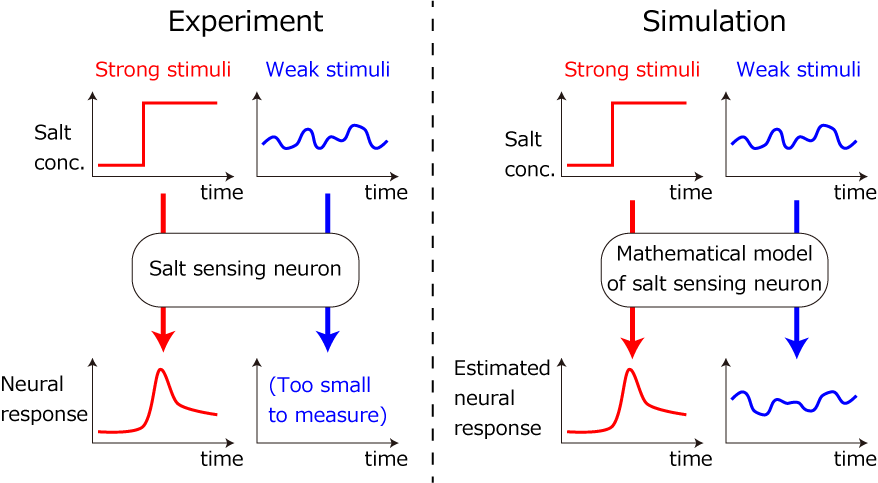<<< Previous page | | Next page >>>
Simulation of neurons and neural circuit
Simulation of neuronal activity
C. elegans has a sense of salt concentrations and moves toward the place with the salt concentration they like. Usually they move slowly, so they feel only a weak and gradual change of salt concentration. However, in order to measure their neuronal activity it is necessary to apply strong and sudden salt concentration changes which they do not usually encounter. Then, how can we know the response to a natural stimulus?
As one way to approach this problem, we can simulate the neuronal activity by mathematical modeling. Here, let's think about a model that can calculate the neuronal activity caused by a change of salt concentration. We can experimentally measure the neuronal activity when strong and sudden salt concentration change is given, and can adjust the parameters of the mathematical model to reproduce the response to the strong stimulus. These parameters may capture the rule of the response to salt concentration changes. Then, it is expected that you can estimate the neuronal activity for a weak stimulus. The estimation will let us predict the neuronal activity when C. elegans is naturally roaming.

Figure. Estimation of a sensory neuronal respose to weak and gradual stimuli through simulation using a mathematical model.
Previous studies have revealed genes related to neuronal activity, learning or memory. Mutants in which specific genes are destroyed were used to study neuronal activity, learning or memory in these studies. However, a neuron has complex network composed of many gene products and it is not easy to estimate the role of specific gene products by foward genetics. A mathematical model which reproduces the mutant neural activity can overview the whole network and may helps solving what roles each molecule plays in each neuron and where learning or memory occurs.
Simulation of neural circuit
When learning and memory occurs, the strength of the connection between neurons often changes. If upstream neurons act in the same way but the activity of downstream neurons changes before and after learning, it indicates that the strength of connection between these neurons has changed. On the other hands, if the activity of upstream neurons has changed, it is obscure whether the strength of the connection has changed. So, how do we estimate the change?
Also in these cases, simulation using a mathematical model is useful. Consider a framework to calculate downstream neuronal activity through upstream neuronal activity. Measure the activities of the upstream and downstream neurons before learning and adjust the model parameters so as to reproduce downstream activity when given the upstream activity. This model expresses the strength of the conection between upstream and downstream neurons. After learning, measure neuronal activities in the same way before learning, esitimate downstream neuronal activity using the model. if there is a great difference in actual activity between estimated activity, you can assert that the strength of connection has changed.
Many animals including C. elegans sense environmental surroundings by sensory neurons and transmit the information to the downstream neurons. In the downstream there is a neural network composed of multiple neurons and this network recieves the information and generates a behavior. To study how the neural network functions, experiments have been done to ablate individual neurons that constitute the network to intervene the circuit and test the outcome. However, study of network itself have reveal that networks have emergence properties and redundancy. Because of these properties, it is insufficient to manipulate single neurons for understanding the whole circuit. Even such a case, a model which reproduces neural activities can estimate how neurons transmit information in the network and how these information are processed.
Related research: Visualization and analysis of neural activity , Observation of the whole nervous system